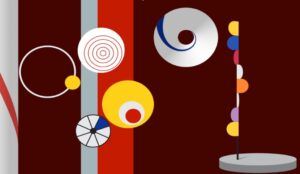Bauhaus – Ukwakha ikhaya: time lapping
‘The Bauhaus was the child of an age that felt itself to be revolutionary. The end of the old and the creation of the new now seemed possible’ – Haus A. (2013)
This write-up contains speculative findings regarding the revolutionary moments in which movements like the Bauhaus are possible – “out of joint”- moments when the linearity of historiography, which is deeply ingrained in colonialism is broken up. Between the emergence of Bauhaus in 1919 after World War I, as a rebuild mechanism, and the contemporary cultural developments and transformations in post-apartheid South Africa. A Zulu translation of the German word Bauhaus is Ukwakha ikhaya (build a home) has a strongly felt resonance here as progress is hard to achieve without a well-built home.
By 1925 the Bauhaus had become more widely known. Ironically it became even more renowned when the school was closed by the Nazis in 1933. This led to a migration of many Bauhaus teachers and students to other parts of the world. The proselytisation of the Bauhaus globally was caused by those members who were part of the setting up of institutions in, for example, the USA, South America, Switzerland, Russia and Israel.

Meekel, Jurgen. 2019. Young People Come to the Bauhaus. Animation after Bauhaus Poster for Harvard.
The humanist Bauhaus ideology was a response to the World War I trauma and the aftermath of its destruction. The school was an important catalyst for developing change and better living conditions in war-ravaged Germany. There is a problematic relationship between war and subsequent increased productivity. As has been evidenced in the aftermath of many other wars around the world, after a war a country can find itself rebuilding and innovating at a soaring pace. Germany, exemplified by the Bauhaus, is an excellent example of this mode of rebuilding, and even reinventing.
The focus of Bauhaus was not only on design but even more on engineering and mass production supported by the advent of the assembly line and electricity becoming widely available.

Meekel, Jurgen. 2019. Pillars. Animation still after silk-screen artwork, Pillars, by Josef Albers 1928.
As is widely known, the effects of the trauma of World War I also influenced Cinema. One example of this is The Cabinet of Dr Caligari, Robert Wiene (1920). The film can be viewed as a social or political analogy of “the moral and physical breakdown of Germany at the time, with a madman on the loose wreaking havoc on a distorted and off-balanced society, a metaphor for a country in chaos”. LoBrutto V. (2005). This version of German expressionist cinema very graphically stylises the insanity of the war. The mis-en-scene displays a distorted visual style synonymous with the large expressionist concrete sculpture ‘Monument to the March Dead‘, Walter Gropius (1922), demolished by the Nazis in 1936.

Meekel, Jurgen 2019. Monument to the March Dead. Animation after Monument to the March Dead, Walter Gropius 1921.
Sibs Shongwe-La Mer’s movie debut Necktie Youth (2015) timestamps a contemporary disillusioned dark impression of a cultural shift in Johannesburg’s youth in the post-apartheid era, as the ‘born free’ generation reach their twenties. It is a bleak autobiographic story of a group of friends that spiral into drug abuse after one of them commits suicide. Necktie Youth uses an aesthetic that was concurrent with the time of the making the film. Necktie Youth actioned a new wave in contemporary South African visual cinematic culture.
Necktie Youth is a crude portrayal of a generation in turmoil and expresses disjointedness. With reference to recent Apartheid history, the millennials in Necktie Youth may not have lived directly through the severe physical trauma of a period like 1914-1918. But they did inherit the wretched aftermath of a highly problematic era. The youth depicted in the film is not particularly poor but they are rudderless. It frames a disillusioned generation on the anniversary day of the violent Soweto Youth uprising of June 16, 1976 trying to find their identity through escapism into a bacchanalic lifestyle filled with drugs. The film is shot in black and white enhancing the grimness. It is an original testament from a young film maker showing a restored society where there is finally the freedom of expression but not without challenges.
The contorted staging of the German expressionist cinema and the grim black and white aesthetic of Necktie Youth both reflect on the socio-political circumstances of their respective times.
Without too much elaboration it is important to mention another influential artistic response on World War I. The Dada movement which perhaps was more insistently in touch with the traumatism of the war, originated mostly in Europe and rejected logic, expressed nonsense as a means to convey their discontent with the war and nationalism. Amongst many others “Without World War I there is no Dada,” says Laurent Le Bon, Laurent Le Bon, president and director of the Musée National Picasso and curator of the Paris Pompidou Center’s Dada exhibition[1]Accessed: July 2019.
Another reflection of Dada is present in the French saying: ‘Dada explains the war more than the war explains Dada.’ Where Dada’s decoding of the war was equal to nonsense, Bauhaus translated the World War I trauma in a way that became a national metaphor for Germany in the 20th and 21st century. Bauhaus wanted to articulate efficiency and logic in their design ideology. The German word Gründlichkeit that translates to diligence and meticulousness describes this condition well and forms a required characteristic for the fusion of art and craft and mass-production of the wonderful design objects that the Bauhaus is famous for.
Prof Stefan Winter from the Berlin Filmuniversität Babelsberg KONRAD WOLF verbalised the ideas behind Dada in this context as follows: ‘If the logics and semantics of the western mainstream discourse led to the consequence of World War I, then lets subvert it – from pure sound poetry that refuses semantics at all (Hugo Ball, Kurt Schwitters) to alienating objects from their known context (Marcel Duchamp) and assembling things that usually don’t belong together (John Heartfield, Meret Oppenheim). The identities emerging in this kind of art, including the group identities, remain kind of nomadic, fluid and moveable, whereas Bauhaus defines itself as a very stable organism including logo design etc.’ Winter S. 2019 (email conversation)

Bauhaus Design
Like industrial and architectural design, graphic design needed to follow rules of hierarchy, colour and placement. The design grid became a useful tool to improve design efficiently. The grid accelerates the production, enhances communication and gives a cleaner look.
Function first, then Form
Especially in industrial design objects needed to be optimised in terms of ergonomics and by reducing the use of materials. The result was functional and minimalist design. Art had to serve a purpose and by using radically simplified forms, the rational and functional design lends itself to mass production. Good design for everyday objects.
In the wake of Germany’s defeat in World War I and the founding of the Weimar Republic, a fresh enlightened spirit allowed new radical experimentation in all the arts. This had not been possible under the old regime. Bauhaus became the backbone of the 20th-centuries classical modernity[2]Habermas J. and Ben-Habib S. Modernity versus Postmodernity New German Critique, No. 22, Special Issue on Modernism. and gives us an insight in the ‘history of modern art’ or perhaps better phrased ‘the history of modern applied art’.

The industrialised approach to industrial design, architecture and crafts that Bauhaus prescribed was precisely what was necessary after the deeply traumatic and chaotic events of World War I. The Bauhaus became synonymous with the general improvement of living; attention was given to the enhancement of living spaces and the creation of attractive but functional and ergonomic furniture. It was a period of optimisation, aided by thinking through the functionality and beauty of objects. There was attention to how light falls into houses and how people move within their living spaces. These were important design aspects of the Bauhaus ideology.
The Dutch artist Piet Mondriaan, who was a follower of the Bauhaus ideas and an essential contributor to the ‘De Stijl’ art movement developed a style named, Neo-Plasticism. His style consisted of a white ground, upon which he painted a grid of black lines and made use of the three primary colours.
”Art has to be forgotten. Beauty must be realised”
Piet Mondriaan.
Opposing the generally celebrated benefits of the Bauhaus the design philosophies of Beatriz Colomina and Mark Wigley in their little yellow book Are we Human? question the current influx of consumer-fetishism in everyday products, for example cellphones. Wigley asks: Is it our goal for humans to become the product that initially was designed to facilitate communication? Their findings are an archaeology of the way design has gone viral and is now, according to them, bigger than the world. ‘Good design promises to produce good humans. However, this promise is inseparable from a globalised industrial complex that threatens humanity.’ Colomina B. and Wigley M. (2017)
This healthy critique aligns to the unsustainable and wasteful desire of the consumer to follow all trends in design, a doubtful capitalist principle that particularly should be questioned. Early twentieth century products were made to last unlike today’s unresolved practice of obsolescence engineering. Wigley therefore questions the importance of Bauhaus. It seems over time, that humanity’s greed has overtaken the initial mass-producing world-saving design ideologies that Bauhaus taught. What was initially a solution has now become our problem, increasingly due to a growing world population.

It is not too difficult to see similarities in how the integration of design and art developed at the Bauhaus in 1919 and how this compares with the post-apartheid millennial uprising of a new wave in cultural developments in SA.
Living prospects in SA are by no means ideal but there seems to be a climate of hope. This hope drives several young emerging designers and artists as for example designer Thebe Magugu whom I will address later, Lady Skollie, Mohau Modisakeng, Michael Mcgarry and Mary Sibande with fresh and relevant ideas that engage with living creatively in the twenty-first century. This new optimism follows the era of hardship where the parents of this current generation had to struggle through. The SA youth represents an ambitious generation that senses the revolutionary breath of new hope.
Neville Dube, who is featuring in the editorial section of this Herri, describes this hope in his unpublished article: The African Renaissance: A Hopeful Gaze at a Looming African Artistic Rebirth:
‘However, we find ourselves at a pinnacle in the cycle of a revolution that serves as a suitable foundation for reestablishment. Change is in the air, and the artist has had a great deal to do with it. For the first time in a long time our canvas; as blank is it may be, is engrained with hope.’
The millennial generation has a new agenda and is ready to play its part on the global art scene without directly using the ‘struggle’ as the first point of departure. The underlying struggle background, however, is not ignored. It is still an essential part of an understanding of the twenty-first century African identity and pays respect to a recent history of trauma. It is rooted in the inherited de-colonisation principles and the need to find a contemporary and constructive language with which to vocalise these narratives in a way to advance the de-colonial perspective.
‘All too often we find ourselves regurgitating western ideas with some traditional African prints on them. If art is to be our medium as a generation, then self-gentrification needs to be cast out. We need to ask ourselves if Africanising anything makes really and truly African in nature.’
The Oxford dictionary translates ‘gentrification’ as follows: ‘The process of renovating and improving a house or district so that it conforms to middle-class taste.’, 2019.
There is no single description for self-gentrification, but freely interpreted one could say: the process of renovating and improving oneself so that one can conform to a middle-class taste.
With this, Dube indicates that there is no wish to conform and compromise to a mediocre standard.


Today, in fashion, talented young designers are surfacing, for example, the fashion designer Thebe Magugu (born in Kimberly -1993). On his Instagram page (@thebemagugu) he writes:
’African Studies” is an introspective collection inspired by motifs and references from my own culture, with visual cues I picked up growing up, revised and reworked. The collection has a lot of hidden, often juxtaposed details – masculine wide-leg pants with a side slit that reveals a silky, lace-trimmed pant-leg (reminiscent of the piles of slips his gran swore by), garments that subtly ‘rip’ to reveal another garment altogether, and pictures (printed on Duchess Satin) stitched into places one might never come across. It is all quite personal, almost acting as an amalgamation of my environment and memories while trying to present key cultural cues from my heritage in modern ways.’ His influences are personal, they widely range from his birthplace, his grandmother, South African art history and the sculptural work of Mary Sibande.

These observations support the hypothesis that South African art, societal and cultural growth are in their prime development stage which is showing us that a new consciousness is emerging. As opposed to the Bauhaus movement which emerged only one year after World War I, the SA rebuild-phenomenon has taken much longer. In SA all generations, the younger in particular, still have a huge task ahead. To an outsider, this may all seem overly optimistic, even naïve, as it is a position not based on hard facts, but more on loose observations and speculations. In the period of the twenty-five years after the 1994 change, it is unlikely that a traumatised nation will rehabilitate within one generation. However, optimism and hope combined with patience and hard work can in time improve prospects for all South Africans. This tenacity is a trait that I have seen in the people who lived through apartheid. As with the Bauhaus it took substantial time, from its birth in 1919 until after World War II to bear the fruits of extended and new creative movements. Only once the Bauhaus was dismantled, and artists left Germany to practice their work, the movement became truly visible in all aspects of art and set the path for improved standards of living.
Mies van der Rohe said ‘Only an idea has the power to spread so widely’.
With reference to this quote, ideas may be small and fragile in their first instance but when picked up by a growing group, applied and then established they become realities that can become powerful and in turn affect living standards.
The hundredth anniversary of the Bauhaus marks a significant milestone. We are able to evaluate its effects on humanity in the twentieth and twenty-first centuries. As part of this retrospective assessment, we should continue to ask ourselves the question of how humanity can sustain itself in the future.
Neville Dube’s editorial looks at African history and critically identifies the many ways Africa was made subservient to the West. He invokes ‘turning a hopeful gaze at a looming African artistic rebirth.’:
‘At no point in our history was life this good. We have never had multi-disciplined individuals skilled in music, visual art, literature and design with adequate social freedom to inspire change till now. After centuries of exploitation, we have learnt a thing or two about milking opportune movements for all their worth. The future of a progressive Africa, despite its past, can now not only be discussed but actioned.’
“A longer version of this text will be published in the book “Radicalise
Bauhaus – Perspectives from the Global South” edited by Katharina Fink,
Alexander Opper & Nadine Siegert, iwalewabooks 2021.”
Colomina, B. and M. Wigley. Are We Human? Notes on an Archaeology of Design. 2017. p83.
Dube, Neville. The African Renaissance: A Hopeful Gaze at a Looming African Artistic Rebirth. Unpublished essay. 2017.
Habermas J. ‘Modernity versus Postmodernity’ New German Critique, No. 22, Special Issue on Modernism 1981. pp. 3-14.
LoBrutto, Vincent. Becoming Film Literate: The Art and Craft of Motion Pictures. 2005. p63.
Trachtman, Paul May, 2006. DOA July 2019
Wiene, R. The Cabinet of Dr. Caligari. 1920.
Winter S. Extract from an email conversation between Stefan Winter and Jurgen Meekel. 2019.
| 1. | ↑ | Accessed: July 2019 |
| 2. | ↑ | Habermas J. and Ben-Habib S. Modernity versus Postmodernity New German Critique, No. 22, Special Issue on Modernism. |